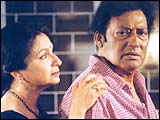 "To me, it is an ode," says filmmaker Goutam Ghose, "not only to [Satyajit] Ray and his movie Aranyer Din Raatri [Days and Nights in the Forest], but to cinema, or more pointedly, to the camera."
"To me, it is an ode," says filmmaker Goutam Ghose, "not only to [Satyajit] Ray and his movie Aranyer Din Raatri [Days and Nights in the Forest], but to cinema, or more pointedly, to the camera.""Only the camera can capture Time. The four of them [characters] are out there on screen, timeless. And frozen in their youth, so I thought, why not bring them back on camera? So I began putting it together."
'It', in this instance, refers to Ghose's ninth feature film, Abar Aranye (In the Forest Again).
As concepts go, it is an interesting one. In 1969, Ray added one more pearl to a luminous string of films, with Aranyer Din Raatri, based on an eponymous novel by Sunil Ganguly for which he wrote the screenplay.
In it, four friends from Kolkata venture out to the forests of Palmau for a holiday. The group comprises the rich Ashim (Soumitra Chatterjee); the timid Sanjoy (Subhendu Chatterjee); the sporty, non-intellectual Hari (Samit Bhanja), who is trying to get over a romantic rejection, and the self-confident, comical Shekhar (Robi Ghosh).
| |||||||||||
The premise is tried and tested -- men and women discovering themselves when pushed in an unfamiliar setting. It becomes a Ray tour de force thanks to brilliant narrative, a masterly mix of the urban and the tribal, and stand out performances.
Ghose, who considers Ray a mentor (he celebrated the auteur in a 1999 documentary), was one among many for whom the work had seminal overtones. At some point, he got to thinking, what if?
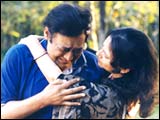 "I played around the pivot," the director explains. "I thought of the trip to the jungle, I thought what if I bring them back together for another trip? Ashim and Aparna are married to each other; the other two have spouses, children; I thought what happens if, after many years, the friends get together again, recreate that landmark trip?"
"I played around the pivot," the director explains. "I thought of the trip to the jungle, I thought what if I bring them back together for another trip? Ashim and Aparna are married to each other; the other two have spouses, children; I thought what happens if, after many years, the friends get together again, recreate that landmark trip?"
"To that plotline, I tried to weave in something else. I asked myself, who is civilised? The city guys who go to the forest to escape the monotony of their lives, or the tribals for whom the forest is home and the city folks are an intrusion on their otherwise ordered existence?"
To expand the narrative, Ghose introduces another character, Amrita (Tabu). Through her, he touches briefly on the 9/11 terrorist strikes in the US, and its tragic aftershocks.
"I was here," says Ghose, speaking from his New York hotel room during a recent visit to attend a screening of his film at the Asia Society, "in early September of 2001. I was in Los Angeles at the time, and a few friends in the East insisted I visit them."
"But I had a prior commitment and had to reach Kolkata. On September 10, I was midair when the tragedy happened. They did not announce it to avoid panic."
"During a brief stopover in Bangkok, I called home and my daughter almost screamed in relief at hearing my voice and knowing I was well. That is when I looked around me, noticed the crowds gathered in front of television screens, and came to know of the horror."
"If I had taken my friends' invite, I could have been in New York at the time. That is a thought that keeps coming back to me."
In the film, Tabu's fiancé is a Turkish guy, who dies in the 9/11 tragedy, leaving her traumatised. "Someone asked me why I made the character Turkish. My point is it doesn't matter. It is tragedy and a loss, whoever it is and whatever his ethnicity."
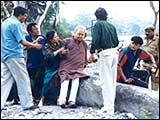 An interesting part of the film is the character of Samit Bhanja, who plays Hari and who, as the film was being made, was already dying of terminal cancer (Bhanja died recently, after the film was completed).
An interesting part of the film is the character of Samit Bhanja, who plays Hari and who, as the film was being made, was already dying of terminal cancer (Bhanja died recently, after the film was completed).
"That is the poignant part of the whole thing," Ghose recalls. "It was his idea. He was suffering and when I approached him to do the role, he was thrilled."
"He hadn't been acting for about two years, but this idea was irresistible to him. Aranyer Din Raatri was his debut film. Somehow, he perhaps saw it appropriate that this sequel would be the last work he ever did."
"He told me, 'Why not make real meet reel, why not make Hari's character terminally ill?'
"That is what we did in this film. He was dying at the time, the schedule had to be woven around his ability to be present, but he loved coming to shoot, he put in long hours and he was so cheerful through it all, it brought a lump to our throats. To Sharmila, more than us, because in the film, there is this scene between the two of them where he talks of his illness."
Bhanja enjoyed it all, Ghose recalls. Making a movie, being part of the bustle, the excitement of creativity. At times, he would lapse into despondency. On one such occasion, he told Ghose, 'Make one more movie with me in it.'
Bhanja, Ghose recalls, was hell bent on finishing the film and seeing it released. "Which he did, and his happiness was so complete, more so when he learnt the film was doing well in the theatres. And then he died."
What is interesting about Ghose's film is that it works, even if you haven't seen Ray's original. If you did, you pick up the tale seamlessly; mentally flashing forward with the director many years in time, to where the once young people are middle-aged, settled, and reliving a seminal experience of their youth for one last time.
But if you do not have that earlier point of reference, it is still the story of a group of adults, friends from way back, going on a picnic. What helps anchor the current story in Ray's tale is Ghose's superb use of clips from the Ray film, in a series of effective flashbacks.
Ghose's excellence lies in the fact that he gets you to join the group on this trip to Palamu. You stay with them in the bungalow, you sip tea with them, you participate in their conversations, you buy into, and somehow become part of, the characters and their interplay.
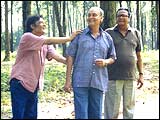 The characters -- even those that have been added on to Ray's original story -- come to life thanks to vivid etching. Like Tabu, brooding over her loss yet capable of setting her cares aside and frolicking with the others. Or Jishu, her companion and family friend. Hari, dying of cancer; Sharmila, his main source of comfort. Shimul (played by Rupa Ganguli), the frisky young wife who loves a drink or two, yet remembers her husband's (Hari's) medication.
The characters -- even those that have been added on to Ray's original story -- come to life thanks to vivid etching. Like Tabu, brooding over her loss yet capable of setting her cares aside and frolicking with the others. Or Jishu, her companion and family friend. Hari, dying of cancer; Sharmila, his main source of comfort. Shimul (played by Rupa Ganguli), the frisky young wife who loves a drink or two, yet remembers her husband's (Hari's) medication.
It is an immersive film. You are as aware of Hari's medical needs as Shimul is. You, like her, wish nothing happens to him. That, by some miracle, he recovers.
Ghose allows you to gradually become part of that picnic, and then he introduces the plot point. Tabu goes missing, and the tension escalates, more so because the incident happens when you least expect it.
From that point on, the film takes a serious tone and tenor. In fact, Ghose has in this aspect, either consciously or unconsciously, recreated the mood of the original film.
In one of Ray's many letters to Marie Seton, a close associate who went on to write one of the best biographies of the master, Portrait Of A Director (1971), he described the structure of Aranyer Din Raatri thus: "The first half has the appearance of a light comedy but there's a steady modulation to a serious key."
Ghose's Abar Aranye has a similar feel. Once Tabu goes missing, the film modulates to a somber, serious note.
You realise Tabu is safe and you are relieved. But the tension continues because her disappearance has the hallmarks of a kidnap. Tension builds, to an unexpected, message-laden denouement.
The climax, and the message it contains, has met with puzzlement. Ghose says he is not out to take a stand, to condone any action. His job, as he sees it, is to plant a thought and see what happens to it.
| Gautam Ghose's Filmography | ||
| Film | Year | |
| Maa Bhoomi (Our Land) | 1980 | |
| Dakhal (The Occupation) | 1982 | |
| Paar (The Crossing) | 1987 | |
| Antarjali Jatra (The Voyage Beyond) | 1987 | |
| Patang (The Kite) | 1993 | |
| Gudia (The Doll) | 1997 | |
| Dekha (Perceptions) | 2000 | |
| Abar Arannye (In The Forest Again) | 2003 | |
The film's strengths are manifold a good concept, superbly executed by cast and crew alike. It helps that Ghose is himself a cinematographer. The marriage of camerawork and directorial intention is seamless.
The film works at many levels. To those who have enjoyed the Ray masterwork, this film is the answer to a question we often ask ourselves: What happens to our favourite characters after the curtain comes down?
The film works as a superb story of human relationships and the confluence of thought and emotion, told with supreme skill.
Ghose, in a director's note, sums up the raison d'etre of his film thus: "The author [Sunil Ganguly] of Satyajit Ray's film had penned a novella out of his own experience of a journey with a few friends in the mid sixties. Ray made the film based on the story, adding his own sensibilities and understanding of a journey. More than three decades later, I have added my own experiences of our turbulent world, through the common journey of two generations.
"Life is a journey and in cinema, we manipulate time and space to understand ourselves better."
His documentaries of which there are over a dozen include 'Ray' (on his mentor, Satyajit Ray); Beyond the Himalayas, a five-hour documentary on the Silk Route; Meeting a Milestone (on Bismillah Khan) and others.
Principal Cast:
Ashim Soumitra Chatterjee
Aparna Sharmila Tagore
Amrita Tabu
Sanjoy Sudhendu Chatterjee
Champa Champa
Saswata Saswata Chatterjee
Bidipta Bidipta Chakrobarty
Hari Samit Banja
Shimul Rupa Ganguly
Jishu Jishu Sengupta
Teacher Arun Mukhopadhyaya
Phagua Arijit Dutta
Crew:
Story, Script, Cinematography, Music and Direction: Goutam Ghose
Producers: Ramesh Ganghi, Sumita Bhattacharya
Executive Producers: Binayak Sarkar, Soma Mukherjee
Art: Ashoke Bose, Sudip Bhattacharya
Costume: Neelanjana Ghose
Editing: Moloy Bannerjee
Choerography: Iliana Citaristi




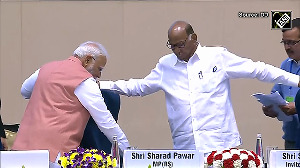
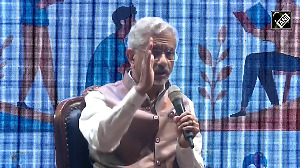
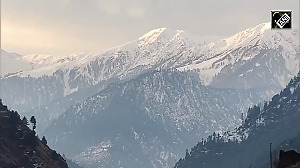
 © 2025
© 2025